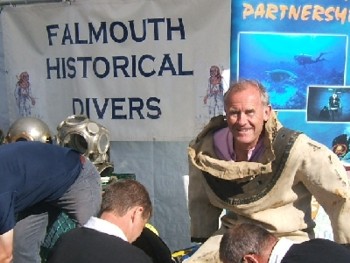|
|
FALMOUTH HISTORICAL DIVERS SUMMER RALLIES
FALMOUTH DOCKS RALLY
In May with the use of the tank, we demonstrated various types of diving equipment for the assembled crowd. The event was a fund raiser for the RNLI and was well attended by members of the public. TV cameras were at hand and there were many displays including the Inshore Lifeboat rescue crew and The Search and Rescue Helicopter from The Royal Navy. The Falmouth Historical Divers shared the tank with the Royal Navy Search and Rescue Divers who demonstrated their wireless communications system . Using a Morse MarkV helmet and suit we used our Morse battery operated Telephone to speak to the diver. Air was supplied by our 3 cylinder Morse pump with back up air from our Gottleib & Weiner hand pump
|
|
ST MAWES-THE ROSELAND PENINSULAR
In early September the working Equipment group visited St Mawes for a demonstration of the shallow water helmet and pump. One of our regular assistants, Grant, is seen here with a volounteer manning a Chinese shallow water pump supplying air to a shallow water helmet. One of the problems we have encountered with this type of equipment is that normal pumping does not give a sufficient amount of air to clear the helmet of water as the diver first submerges. To overcome this problem we have fitted in the air line, a surge vessel with stored pressure. . As the diver begins to submerge the outlet valve is opened fully allowing a momentary blast of air to clear the helmet. From then on the pump has sufficient capacity to keep the air pressure in the helmet at the same pressure as the water pressure outside the helmet.
|
|
ROYAL NAVAL AIR STATION CULDROSE
In June as guests of the Royal Navy we took some our equipment to RNAS Culdrose in Helston. Using the test tank Divers from Falmouth Historical Divers demonstrate one of their outfits, a 1940s Siebe Gorman helmet and gear previously owned by The Liverpool Dock Authority.
|
|
Air is pumped to the diver from a Siebe Gorman 'Baby' pump while the diver plays noughts and crosses with members of the audience. Other items of historical interest are displayed including underwater tools and lamps and helmets.
|
|
The diver waits for the first move |
In the background helicopters can be seen. |
AUGUST BANK HOLIDAY-FALMOUTH
 |
In August, Falmouth Historical Divers put on a demonstration on behalf of the RNLI. An audience quickly gathered to see two guests from Essex dress in to a 1940 Morse MarkV outfit. The group laid on the popular diver of to-day and yesteryear demonstration , comparing and contrasting the Standard gear with the modern Scuba gear along with state of the art Rebreather equipment. In the background of this picture you can see a rare Lindbergh-Hammar air recirculating helmet, similar in design to the Yokahama and the Kirby Morgan air recirculating helmets. |
|
Diver Bull Hulse from Essex returns after taking the plunge in a Snead shallow water helmet . Air is pumped to the diver from a 1915 Morse 3 cylinder pump. The Helmet is heavy and cumbersome when out of the water and can feel top heavy but as soon as the diver is in the water the weight is almost unnoticeable and he can move around freely and with ease. The helmet of course is open at the bottom so the air pressure inside the helmet keeps the water out. It is therefore very important that the helmet is kept in an upright position as much as is possible. Designs in shallow water helmets vary . Some are made of heavy materials like bronze or cast iron. These do not need extra weights to keep them underwater, whereas copper or steel helmets require lead weights to counter the weight of water displaced.. With so much weight on the diver's shoulders it's important the design is well balanced and comfortable
|
|
Here we see our friend from Exmouth, Kevin Riley about to make his first dive in Standard equipment. He is wearing a Drager 3 bolt 4 light helmet. Hanging from his chest you can see his reserve air supply should the main supply fail. There is a control valve which is operated by his right hand and there is enough air stored in the 2 cylinders at high pressure to ensure the diver can get back to the surface. Over Kevin's right hand shoulder you can just make out the Cornwall Maritime Museum which has also been the venue for a demonstration in the past. The award winning building has a Nav Station, Floating pontoon, a Famous Boats display and a Tidal zone where you can see the sea from below the water surface in a specially built underwater observation gallery. Why not visit the Museum at http://www.nmmc.co.uk
|
|
Last edited: 21 April 2006.
Copyright © 2006 by Diving Heritage.